Global seagrass trajectories project launched
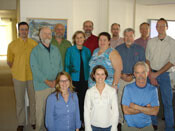 A working group of a dozen scientists from Australia, Europe and the U.S. was established in February 2006 at the National Center for Ecological Analysis and Synthesis (NCEAS) in Santa Barbara, California. Drs. Bill Dennison and Tim Carruthers helped initiate a two-year project in which a global assessment of seagrass gains and losses will be used to develop ecological forecasts. The project, “Global trajectories of seagrasses: Establishing a quantitative basis for seagrass conservation and restoration”, is constructing a global database of seagrass distributional changes, testing the perception that a contemporary crisis in seagrass ecosystems is occurring due to coastal human population pressures.
A working group of a dozen scientists from Australia, Europe and the U.S. was established in February 2006 at the National Center for Ecological Analysis and Synthesis (NCEAS) in Santa Barbara, California. Drs. Bill Dennison and Tim Carruthers helped initiate a two-year project in which a global assessment of seagrass gains and losses will be used to develop ecological forecasts. The project, “Global trajectories of seagrasses: Establishing a quantitative basis for seagrass conservation and restoration”, is constructing a global database of seagrass distributional changes, testing the perception that a contemporary crisis in seagrass ecosystems is occurring due to coastal human population pressures.
ISBW 7 Conference 2006
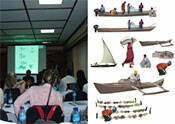 On September 10-15, Tim Carruthers from the IAN group attended the seventh International Seagrass Biology Workshop (ISBW7) in Zanzibar, Tanzania. Tim gave a presentation on work being carried out with an NCEAS (National Center for Ecological Analysis and Synthesis) project on Global Seagrass Trajectories, entitled “A Global Crisis for Seagras Ecosystems?”. He also gave a short workshop on techniques in effective science communication.
On September 10-15, Tim Carruthers from the IAN group attended the seventh International Seagrass Biology Workshop (ISBW7) in Zanzibar, Tanzania. Tim gave a presentation on work being carried out with an NCEAS (National Center for Ecological Analysis and Synthesis) project on Global Seagrass Trajectories, entitled “A Global Crisis for Seagras Ecosystems?”. He also gave a short workshop on techniques in effective science communication.
A global crisis for seagrass ecosystems; Orth et al 2006
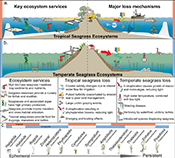 This paper, just out in Bioscience (December 2006 56(12): 987-996), is the first synthesis product of an NCEAS (National Center for Ecological Analysis and Synthesis) project on Global Seagrass Trajectories in which Bill Dennison and Tim Carruthers from IAN are participating. The paper concludes that "There is a critical need for a targeted global conservation effort that includes a reduction of watershed nutrient and sediment inputs to seagrass habitats and a targeted educational program informing regulators and the public of the value of seagrass meadows".
This paper, just out in Bioscience (December 2006 56(12): 987-996), is the first synthesis product of an NCEAS (National Center for Ecological Analysis and Synthesis) project on Global Seagrass Trajectories in which Bill Dennison and Tim Carruthers from IAN are participating. The paper concludes that "There is a critical need for a targeted global conservation effort that includes a reduction of watershed nutrient and sediment inputs to seagrass habitats and a targeted educational program informing regulators and the public of the value of seagrass meadows".
New seagrass fact sheet
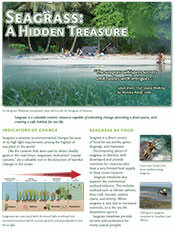 A seagrass fact sheet was produced by the Integration and Application Network entitled "Seagrass: A Hidden Treasure" to complement a previous fact sheet entitled "Seagrasses: Prairies of the Sea". These fact sheets are part of a series of images, diagrams, and fun facts produced by the Global Seagrass Trajectories working group, funded by the National Science Foundation and conducted at the National Center for Ecological Analysis and Synthesis in Santa Barbara, California. Both seagrass fact sheets can be downloaded as pdfs from the IAN website. Drs. Bill Dennison and Tim Carruthers participated in the working group, along with a dozen seagrass colleagues from around the world.
A seagrass fact sheet was produced by the Integration and Application Network entitled "Seagrass: A Hidden Treasure" to complement a previous fact sheet entitled "Seagrasses: Prairies of the Sea". These fact sheets are part of a series of images, diagrams, and fun facts produced by the Global Seagrass Trajectories working group, funded by the National Science Foundation and conducted at the National Center for Ecological Analysis and Synthesis in Santa Barbara, California. Both seagrass fact sheets can be downloaded as pdfs from the IAN website. Drs. Bill Dennison and Tim Carruthers participated in the working group, along with a dozen seagrass colleagues from around the world.
San Francisco Estuary report card scoping workshop
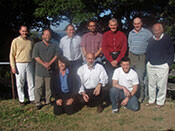 A workshop sponsored by the National Center for Ecological Analysis and Synthesis was held at the Romberg Tiburon Center for Environmental Studies on the shores of San Francisco Bay. The scoping workshop was organized by Drs. Erica Fleishman (NCEAS), Wim Kimmerer (San Francisco State University) and Bill Dennison (IAN). Workshop participants developed a report card framework based on the pelagic organism decline in the San Francisco Estuary. The pelagic organism decline is a relatively recent (ca. 2000), precipitous reduction in the numbers of various species of estuarine fish (e.g., delta smelt, threadfin smelt, longfin smelt and striped bass). A suite of water quality parameters and habitat features relevant to the pelagic organism decline was developed to form the draft indicators for a San Francisco Estuary report card.
A workshop sponsored by the National Center for Ecological Analysis and Synthesis was held at the Romberg Tiburon Center for Environmental Studies on the shores of San Francisco Bay. The scoping workshop was organized by Drs. Erica Fleishman (NCEAS), Wim Kimmerer (San Francisco State University) and Bill Dennison (IAN). Workshop participants developed a report card framework based on the pelagic organism decline in the San Francisco Estuary. The pelagic organism decline is a relatively recent (ca. 2000), precipitous reduction in the numbers of various species of estuarine fish (e.g., delta smelt, threadfin smelt, longfin smelt and striped bass). A suite of water quality parameters and habitat features relevant to the pelagic organism decline was developed to form the draft indicators for a San Francisco Estuary report card.
Trophic transfers from seagrass meadows
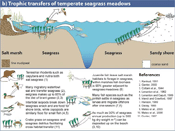 This minireview published in Ecosystems is the latest publication from a synthesis effort at the National Center for Ecological Analysis and Synthesis (NCEAS) in which IAN staff participated. The review found that seagrass ecosystems provide a large subsidy to both near and distant locations through the export of particulate organic matter as well as living plant and animal biomass. Therefore, the consequences of continuing seagrass decline extend far beyond the areas where seagrasses grow.
This minireview published in Ecosystems is the latest publication from a synthesis effort at the National Center for Ecological Analysis and Synthesis (NCEAS) in which IAN staff participated. The review found that seagrass ecosystems provide a large subsidy to both near and distant locations through the export of particulate organic matter as well as living plant and animal biomass. Therefore, the consequences of continuing seagrass decline extend far beyond the areas where seagrasses grow.
Accelerating loss of seagrasses across the globe threatens coastal ecosystems
 This global assessment of 215 studies found that seagrasses have been disappearing at a rate of 110 km2 yr-1 since 1980. Rates of decline have accelerated from a median of 0.9% yr-1 before 1940 to 7% yr-1 since 1990. Seagrass loss rates are comparable to those reported for mangroves, coral reefs, and tropical rainforests and place seagrass meadows among the most threatened ecosystems on earth. Bill Dennison and Tim Carruthers from IAN were co-authors on this paper, published as an open access online article in the Proceedings of the National Academy of Science, which resulted from a series or workshops at NCEAS, UC Santa Barbara (National Center for Ecosystem Analysis and Synthesis).
This global assessment of 215 studies found that seagrasses have been disappearing at a rate of 110 km2 yr-1 since 1980. Rates of decline have accelerated from a median of 0.9% yr-1 before 1940 to 7% yr-1 since 1990. Seagrass loss rates are comparable to those reported for mangroves, coral reefs, and tropical rainforests and place seagrass meadows among the most threatened ecosystems on earth. Bill Dennison and Tim Carruthers from IAN were co-authors on this paper, published as an open access online article in the Proceedings of the National Academy of Science, which resulted from a series or workshops at NCEAS, UC Santa Barbara (National Center for Ecosystem Analysis and Synthesis).

